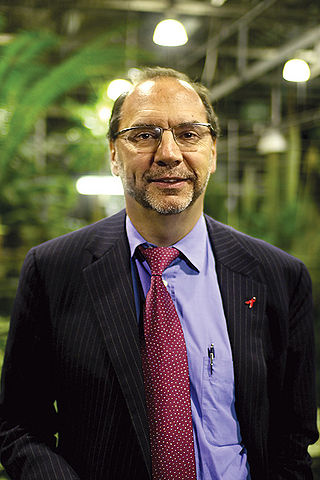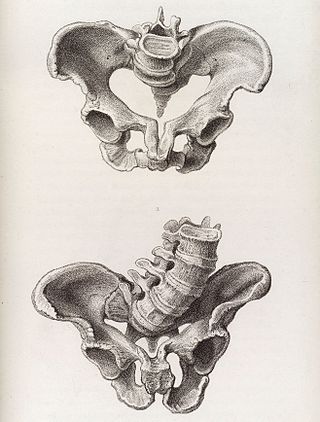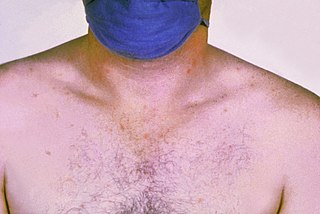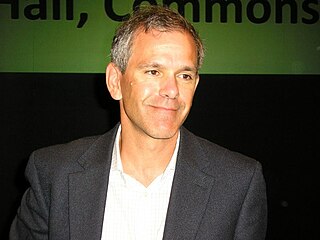Related Research Articles

Mortality rate, or death rate, is a measure of the number of deaths in a particular population, scaled to the size of that population, per unit of time. Mortality rate is typically expressed in units of deaths per 1,000 individuals per year; thus, a mortality rate of 9.5 in a population of 1,000 would mean 9.5 deaths per year in that entire population, or 0.95% out of the total. It is distinct from "morbidity", which is either the prevalence or incidence of a disease, and also from the incidence rate.

Sir Peter Karel, Baron Piot, is a Belgian-British microbiologist known for his research into Ebola and AIDS.

The World Health Assembly (WHA) is the forum through which the World Health Organization (WHO) is governed by its 194 member states. It is the world's highest health policy setting body and is composed of health ministers from member states.

Obstructed labour, also known as labour dystocia, is the baby not exiting the pelvis because it is physically blocked during childbirth although the uterus contracts normally. Complications for the baby include not getting enough oxygen which may result in death. It increases the risk of the mother getting an infection, having uterine rupture, or having post-partum bleeding. Long-term complications for the mother include obstetrical fistula. Obstructed labour is said to result in prolonged labour, when the active phase of labour is longer than 12 hours.

Global health is the health of the populations in the worldwide context; it has been defined as "the area of study, research, and practice that places a priority on improving health and achieving equity in health for all people worldwide". Problems that transcend national borders or have a global political and economic impact are often emphasized. Thus, global health is about worldwide health improvement, reduction of disparities, and protection against global threats that disregard national borders, including the most common causes of human death and years of life lost from a global perspective.
Enterotoxigenic Escherichia coli (ETEC) is a type of Escherichia coli and one of the leading bacterial causes of diarrhea in the developing world, as well as the most common cause of travelers' diarrhea. Insufficient data exists, but conservative estimates suggest that each year, about 157,000 deaths occur, mostly in children, from ETEC. A number of pathogenic isolates are termed ETEC, but the main hallmarks of this type of bacterium are expression of one or more enterotoxins and presence of fimbriae used for attachment to host intestinal cells. The bacterium was identified by the Bradley Sack lab in Kolkata in 1968.

Paratyphoid fever, also known simply as paratyphoid, is a bacterial infection caused by one of three types of Salmonella enterica. Symptoms usually begin 6–30 days after exposure and are the same as those of typhoid fever. Often, a gradual onset of a high fever occurs over several days. Weakness, loss of appetite, and headaches also commonly occur. Some people develop a skin rash with rose-colored spots. Without treatment, symptoms may last weeks or months. Other people may carry the bacteria without being affected; however, they are still able to spread the disease to others. Typhoid and paratyphoid are of similar severity. Paratyphoid and typhoid fever are types of enteric fever.
The Global Burden of Disease Study (GBD) is a comprehensive regional and global research program of disease burden that assesses mortality and disability from major diseases, injuries, and risk factors. GBD is a collaboration of over 3600 researchers from 145 countries. Under principal investigator Christopher J.L. Murray, GBD is based in the Institute for Health Metrics and Evaluation (IHME) at the University of Washington and funded by the Bill and Melinda Gates Foundation.

Disease burden is the impact of a health problem as measured by financial cost, mortality, morbidity, or other indicators. It is often quantified in terms of quality-adjusted life years (QALYs) or disability-adjusted life years (DALYs). Both of these metrics quantify the number of years lost due to disability (YLDs), sometimes also known as years lost due to disease or years lived with disability/disease. One DALY can be thought of as one year of healthy life lost, and the overall disease burden can be thought of as a measure of the gap between current health status and the ideal health status. According to an article published in The Lancet in June 2015, low back pain and major depressive disorder were among the top ten causes of YLDs and were the cause of more health loss than diabetes, chronic obstructive pulmonary disease, and asthma combined. The study based on data from 188 countries, considered to be the largest and most detailed analysis to quantify levels, patterns, and trends in ill health and disability, concluded that "the proportion of disability-adjusted life years due to YLDs increased globally from 21.1% in 1990 to 31.2% in 2013." The environmental burden of disease is defined as the number of DALYs that can be attributed to environmental factors. Similarly, the work-related burden of disease is defined as the number of deaths and DALYs that can be attributed to occupational risk factors to human health. These measures allow for comparison of disease burdens, and have also been used to forecast the possible impacts of health interventions. By 2014, DALYs per head were "40% higher in low-income and middle-income regions."

Although emphasized by the country's ruling Baath Party and improving significantly in recent years, health in Syria has been declining due to the ongoing civil war. The war which has left 60% of the population food insecure and saw the collapse of the Syrian economy, the surging prices of basic needs, the plummeting of the Syrian pound, the destruction of many hospitals nationwide, the deterioration in the functionality of some medical equipment due to the lack of spare parts and maintenance, and shortages of drugs and medical supplies due to sanctions and corruption.
In 2006, life expectancy for males in Cyprus was 79 and for females 82 years. Infant mortality in 2002 was 5 per 1,000 live births, comparing favourably to most developed nations.

Christopher J. L. Murray is an American physician, health economist, and global health researcher. He is a professor at the University of Washington in Seattle, where he is Chair of Health Metrics Science and the director of the Institute for Health Metrics and Evaluation (IHME).

The Institute for Health Metrics and Evaluation (IHME) is a national and international public health agency and research institute working in the area of global health statistics and impact evaluation, located at the University of Washington in Seattle. IHME is headed by Christopher J.L. Murray, a physician, health economist, and global health researcher, and professor at the University of Washington Department of Global Health, which is part of the School of Medicine. IHME conducts research and trains scientists, policymakers, and the public in health metrics concepts, methods, and tools. Its mission includes judging the effectiveness and efficacy of health initiatives and national health systems. IHME also trains students at the post-baccalaureate and post-graduate levels.

Sir Alimuddin Zumla,, FRCP, FRCPath, FRSB is a British-Zambian professor of infectious diseases and international health at University College London Medical School. He specialises in infectious and tropical diseases, clinical immunology, and internal medicine, with a special interest in HIV/AIDS, respiratory infections, and diseases of poverty. He is known for his leadership of infectious/tropical diseases research and capacity development activities. He was awarded a Knighthood in the 2017 Queens Birthday Honours list for services to public health and protection from infectious disease. In 2012, he was awarded Zambia's highest civilian honour, the Order of the Grand Commander of Distinguished services - First Division. In 2023, for the sixth consecutive year, Zumla was recognised by Clarivate Analytics, Web of Science as one of the world's top 1% most cited researchers. In 2021 Sir Zumla was elected as Fellow of The World Academy of Sciences.
The Million Death Study (MDS) is an ongoing human premature mortality study conducted in India. It began in 1998 and ended in 2014. Among a sample size of 14 million Indians, approximately 1 million deaths are assigned as medical causes through the Verbal Autopsy method to determine disease patterns and direct public health policy. The principal investigator of the study is Dr. Prabhat Jha, director of the Centre for Global Health Research and professor of epidemiology at the Dalla Lana School of Public Health, University of Toronto, Canada.

Childbirth in Iraq is marked by a fertility rate of 4.0 births per woman, a contested but high maternal mortality rate and a moderately high infant mortality rate.

Michael Joseph Ryan is an Irish epidemiologist and former trauma surgeon, specialising in infectious disease and public health. He is executive director of the World Health Organization's Health Emergencies Programme, leading the team responsible for the international containment and treatment of COVID-19. Ryan has held leadership positions and has worked on various outbreak response teams in the field to eradicate the spread of diseases including bacillary dysentery, cholera, Crimean–Congo hemorrhagic fever, Ebola, Marburg virus disease, measles, meningitis, relapsing fever, Rift Valley fever, SARS, and Shigellosis.

The Vaccine Confidence Project (VCP) founded in 2010 by Heidi Larson, was developed in response to hesitancy and misinformation on vaccination programmes such as those that caused a boycott of polio eradication efforts in Northern Nigeria in 2003–04. It is an early warning system to identify and evaluate public confidence in vaccines, with the purpose of tackling the problem early, when it is likely to be manageable.

The commercial determinants of health are the private sector activities that influence individual and group differences in health status. Commercial determinants of health can affect people's health positively or negatively. They are part of the broader social determinants of health.
References
- 1 2 "Global Health Observatory (GHO)". World Health Organization. Archived from the original on 3 July 2014. Retrieved 3 July 2014.
- ↑ Holtz, Carol, ed. (2013). Global Health Care: Issues and Policies. Jones & Bartlett Publishers. p. 60.
- ↑ "WHO > Programmes and projects > Global Health Observatory (GHO)". World Health Organization. Archived from the original on 30 April 2010.
- ↑ "Global Health Observatory – the one-stop shop for health data". World Health Organization. December 2012. Archived from the original on December 4, 2013. Retrieved July 3, 2014.
- ↑ "Mortality and global health estimates". Global Health Observatory section, World Health Organization . Retrieved July 3, 2014.
- ↑ "Health systems". Global Health Observatory section, World Health Organization. Archived from the original on April 13, 2014. Retrieved July 3, 2014.
- ↑ "Public health and environment". Global Health Observatory section, World Health Organization . Retrieved July 3, 2014.
- ↑ "Health equity". Global Health Observatory section, World Health Organization . Retrieved July 3, 2014.
- ↑ "International Health Regulations (2005) Monitoring Framework". Global Health Observatory section, World Health Organization . Retrieved July 3, 2014.
- ↑ "Urban health". Global Health Observatory section, World Health Organization. Archived from the original on July 6, 2014. Retrieved July 3, 2014.
- ↑ "Women and Health". Global Health Observatory section, World Health Organization . Retrieved July 3, 2014.
- ↑ "Noncommunicable diseases". Global Health Observatory section, World Health Organization . Retrieved July 3, 2014.
- ↑ "World Health Organisation, Global Health Observatory". The Macro Data Guide. Archived from the original on July 3, 2014. Retrieved July 3, 2014.
- ↑ "Global Health Observatory (GHO)". OpenHealthNews. Retrieved July 3, 2014.
- ↑ "Global Health Observatory (GHO)". Fondren Library, Rice University. Archived from the original on July 5, 2014. Retrieved July 3, 2014.
- ↑ "Global Health Observatory (GHO)". MCH Data Connect Dataverse. Archived from the original on July 6, 2014. Retrieved July 3, 2014.
- ↑ Bartolomeos, Kidist (September 19, 2010). "The Global Health Observatory (GHO) Home for injury indicators?" (PDF). Retrieved July 3, 2014.
- ↑ Hallal, P. C.; Andersen, L. B.; Bull, F.; Guthold, R.; Haskell, W.; Ekelund, U. (2012). "Global physical activity levels: surveillance progress, pitfalls, and prospects" (PDF). The Lancet . 380 (9838): 247–257. doi:10.1016/s0140-6736(12)60646-1. hdl: 11250/170988 . PMID 22818937. S2CID 8186207.
- ↑ Adhikari, Neill KJ; Fowler, Robert A.; Bhagwanjee, Sathish; Rubenfeld, Gordon D. (October 19, 2010). "Critical care and the global burden of critical illness in adults". The Lancet . 376 (9749): 1339–1346. doi:10.1016/s0140-6736(10)60446-1. PMC 7136988 . PMID 20934212.
- ↑ "Data". World Bank . Retrieved July 3, 2014.